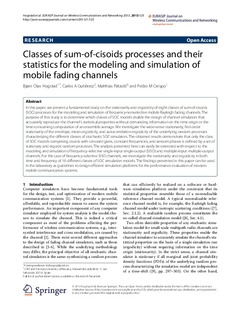Classes of sum-of-cisoids processes and their statistics for the modeling and simulation of mobile fading channels
Journal article, Peer reviewed
Permanent lenke
http://hdl.handle.net/11250/138008Utgivelsesdato
2013Metadata
Vis full innførselOriginalversjon
Hogstad, B. O., Gutiérrez, C. A., Pätzold, M., & Crespo, P. M. (2013). Classes of sum-of-cisoids processes and their statistics for the modeling and simulation of mobile fading channels. EURASIP Journal on Wireless Communications and Networking, 2013(1), 1-15. doi: 10.1186/1687-1499-2013-125 10.1186/1687-1499-2013-125Sammendrag
In this paper, we present a fundamental study on the stationarity and ergodicity of eight classes of sum-of-cisoids (SOC) processes for the modeling and simulation of frequency-nonselective mobile Rayleigh fading channels. The purpose of this study is to determine which classes of SOC models enable the design of channel simulators that accurately reproduce the channel’s statistical properties without demanding information on the time origin or the time-consuming computation of an ensemble average. We investigate the wide-sense stationarity, first-order stationarity of the envelope, mean ergodicity, and autocorrelation ergodicity of the underlying random processes characterizing the different classes of stochastic SOC simulators. The obtained results demonstrate that only the class of SOC models comprising cisoids with constant gains, constant frequencies, and random phases is defined by a set of stationary and ergodic random processes. The analysis presented here can easily be extended with respect to the modeling and simulation of frequency-selective single-input single-output (SISO) and multiple-input multiple-output channels. For the case of frequency-selective SISO channels, we investigate the stationarity and ergodicity in both time and frequency of 16 different classes of SOC simulation models. The findings presented in this paper can be used in the laboratory as guidelines to design efficient simulation platforms for the performance evaluation of modern mobile communication systems.
Beskrivelse
Published version of an article in the journal: EURASIP Journal on Wireless Communications and Networking. Also available from the publisher at: http://dx.doi.org/10.1186/1687-1499-2013-125 Open access
